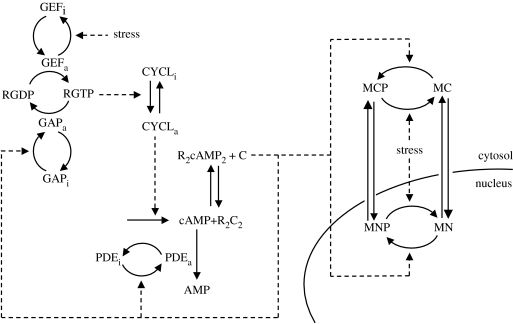Figure 1.
Scheme of the model for Msn2 nucleocytoplasmic shuttling coupled with the cAMP–PKA pathway in yeast. The cAMP–PKA system involves GEF, RAS, GAP, adenylate cyclase (CYCL), phosphodiesterase (PDE), cAMP and PKA. R2C2 represents the inactive form of PKA, while C represents its free, active catalytic subunit. For clarity of the scheme, the forms R2C2 and C are shown only in the cytoplasm but are also present in the nucleus. Four forms of Msn2 are considered: cytosolic non-phosphorylated Msn2 (MC), cytosolic phosphorylated Msn2 (MCP), nuclear non-phosphorylated Msn2 (MN) and nuclear phosphorylated Msn2 (MNP). Stress is assumed to decrease the activity of GEF and to enhance the dephosphorylation of Msn2. Two negative feedback loops in the cAMP–PKA pathway involve the activation of GAP and of PDE through phosphorylation by the catalytic subunit C of PKA. Oscillations in cAMP and PKA resulting from this regulation underlie the oscillatory nucleocytoplasmic shuttling of Msn2 (see text and Garmendia-Torres et al. (2007) for further details).

